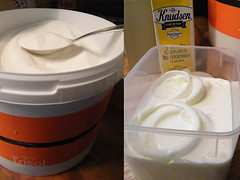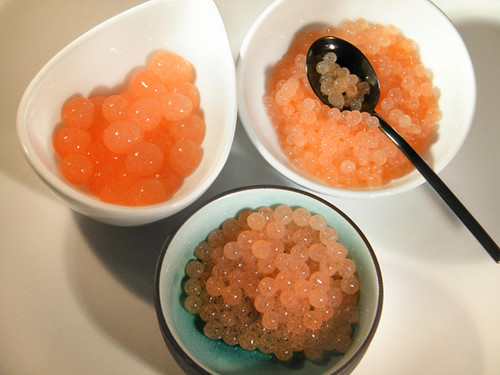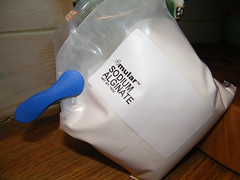“Trisol” for crispier, less greasy frying!
I first learned about Trisol on the Chadzilla website (link below). It’s one of my favorite “molecular gastronomy” blogs and I’m always inspired by the photos and information they post.
Chadzilla wrote:
“We have been working with incorporating the Adria’s Surpises product Trisol into fried food textures. It’s a wheat starch that can be used in a dry mix with AP flour (70% flour: 30% trisol) or in batters. The great benefit is that it buys time for the chef if the fried product has to sit a minute. This could obviously be seen as advantageous during large groups or parties, but the real advantage is the texture which is amazingly crispy.”
 More about Trisol (as noted on La Tienda’s website):
More about Trisol (as noted on La Tienda’s website):
“Trisol : Is a soluble fibre derived from wheat, especially recommended for the preparation of frying batter and tempura, the result being a crunchy, not at all oily, texture. It is also perfect as a substitute for sugar in the preparation of doughs for biscuits. Characteristics: Available in soluble powder form with neutral taste and smell. It keeps tempura crunchy even with the most moist products.”
I immediately purchased the Trisol and when it arrived a few days later, I was surprised to find it came in a bowling bag size tub! The previous Textura products I’d ordered came in cute, little “V8” juice size cans containing just 100 grams in each. The Trisol tub weighed in at 4 kilos (8.8 pounds)! What a great excuse to have a good old fashioned FRY-UP! All in the name of “research” of course.
 Trisol Fry-Up Test #1 – Buttermilk Onion Rings.
Trisol Fry-Up Test #1 – Buttermilk Onion Rings.
Using a simple buttermilk recipe, I incorporated the Trisol:
I sliced the onion rings and placed in a large container.
Poured buttermilk over, covered and placed in fridge for about 1/2 an hour.
Next I prepped two bowls of all-purpose flour then added salt & pepper.
Then I added Trisol to each.
 In one bowl I had 70% flour to 30% Trisol.
In one bowl I had 70% flour to 30% Trisol.
In the other bowl I had 50% flour to 50% Trisol (just to see if there was a huge difference after frying).
I mixed them both (separately) then heated up vegetable oil for frying (to 350 degrees).
I then drained the onion rings from the buttermilk, but reserved the buttermilk in a shallow pan so I could coat each piece twice.
1. Take wet (from buttermilk) onion ring
2. Dredge in flour / Trisol
3. Dip in buttermilk a second time
4. Dredge again in flour / Trisol
5. Fry in batches for about 3 minutes or until golden brown.
6. Drain on paper towels and add salt immediately (while still hot).

The first batch I fried were the 30% Trisol (as noted on the Chadzilla site). They were still crispy after I left them sitting on the counter for four hours. GREAT for dinner parties!
The 50% Trisol were lighter in weight and much crispier of course, but they were almost “too crunchy”.
Trisol Fry-Up Test #2 – Asparagus, Tofu Squares and Mozzarella Sticks.
My sister Janet’s kids loved fried foods. They’re not allowed to have them very often though, because my super-healthy sister does NOT. Needless to say, she was less than thrilled when I showed up at her house carrying the tub of Trisol, for “deep-frying research”.
The twins (ages 13) helped me clean and trim some asparagus and then I asked Janet what things we could grab from the fridge. This is when it got fun! After searching through all the drawers, we decided to fry mozzarella sticks, jalapenos and tofu squares (just for my sister).
We marinated each item separately in buttermilk, then got to the fry-up. This time I decided to test 60% flour to 40% Trisol. Following the same instructions as above, we first fried up the asparagus, then jalapenos, tofu squares, and finally the cheese (in case it oozed).
Janet made a huge garden salad and we sat down to our “Deep-Fried-Enjoy-It-Now” (because it will NEVER happen again dinner)! And what did my marathon-running-healthy-eating sister think of the Trisol? She LOVED it. The fact that it wasn’t so greasy made her enjoy it, and we were all shocked to see her reaching for more.
We dipped some bites in ranch dressing, others in ketchup and ate the asparagus on it’s own. I was surprised how much I liked the tofu, since I had cooked it up especially for my sister, but we were fighting over the last, crispy square. The Trisol did a great job holding the tofu wetness inside and I’m definitely going make agedashi tofu soon.
After trying the three Trisol recipes, I liked the 60/40 combination the best. Unfortunately (or fortunately!) I still have half a TUB (four pounds) of Trisol left, and it’s taking up space in my small kitchen. I really don’t deep-fry too often at home, but I guess I’ll have to plan a few more fry-ups in the near future, all in the name of molecular “research” of course!

Mozzarella Sticks, Tofu Squares, Onion Rings, (jalapeno underneath)
Mentioned above:
Adria’s Textura Website (in Spanish)
Texturas products I have at home













































